Introduction of Synology’s new copy range
Something that many still find difficult to understand is that Synology is not a hardware brand, is a software brand that relies on its own hardware. It is the same way other large and well-known manufacturers understand their business today. Tesla is a good example in fact, the same platform where the software represents advancement and change.
Until now, Synology understood customized solutions through the incredible and easy customization of functions of its NAS from the DS, RS, etc. range. All of these models had something in common, the magnificent Synology DSM operating system. Now they are taking a risk with a solution completely oriented to backup, including a new operating system, although it is not the first time they have ventured, they already did it with an excellent range of routers.
Today we are going to review the needs of modern backup, the new challenges and how Synology wants to offer a complete solution thanks to its new Synology DP Series supported by its new Synology ActiveProtect operating system.
The renewed importance of backup
Today’s challenges require different ways of understanding backup. Not only are there new threats in the form of ransomware, even capable of encrypting and modifying our traditional backups, But in a fully connected world we can no longer leave loose ends in our copying processes.
This means that we have to cover not only central data but also departments, branches, laptops and desktops intended for teleworking, etc. All of this centrally, so that management is transparent, efficient and simple.

Another challenge is how to handle all that data, how to be able to restore systems quickly, how to handle all those completely heterogeneous systems and How to combine “on-premise” solutions with service solutions, as a cloud storage system. This, for Synology, requires a completely personalized and tailored solution.
One of the most critical elements of modern copies is their immutability and also how quickly we can recover our systems. How many times have we heard of public and private systems that are attacked and are even weeks without being able to recover the service.
This is because the remote and local copies are of poor quality and have also been affected by the attack and as much or more important in the speed of recovery, especially when we try to do it from remote points, cold storages, which are difficult to put online by its very essence.
The backup copies offered by the new Synology DP solutions with ActiveProtect They are completely immutable, meaning they cannot be altered or deleted, intentionally or accidentally. Furthermore, it does not understand real or virtual machines and offers another series of features that we will now explain.
What is Synology ActiveProtect?
Synology ActiveProtect It is a completely specialized system dedicated solely to backup and the devices that integrate it are only designed for this objective, making backup copies. The goal is to be able to have a backup system from heterogeneous sources, less mobile devices, running and up and running in less than 10 minutes.
ActiveProtect adds as many local systems, or clusters of other drives running the same operating system, so that they are accessible for backup purposes. SaaS cloud services such as Google Workspace or Microsoft 365, Linux-based servers, your own NAS based on the DSM operating systemWindows servers and of course any variant of these systems, whether running on “real machines” or virtual ones.
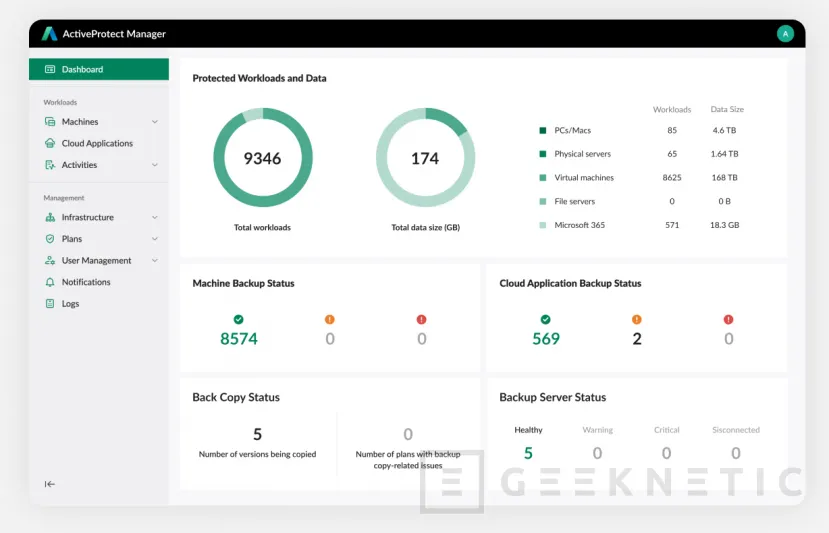
Supports copying from Microsoft and Broadcom VMWare hypervisors in a completely simple and transparent way. It gives them quick, centralized access to a single copy control pool where it is easy to create, view, map and control each device connected to the copy storage. It also allows you to add multiple Synology DP devices as a Copy Cluster.
The copy allows us to easily decide the frequency, the retention policy of copies (number of them that we keep in the unit), the copies outside the environment, undoubtedly critical, the retention policy of the copy outside the environment and, very important , the immutability of the copy. A system that is also completely scalable, either by adding more storage to the unit itself, or by combining more units progressively.
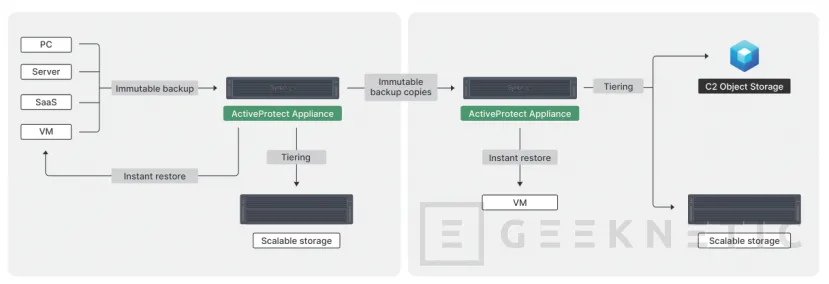
Where this system, and the associated hardware, shines is really in the recovery capabilities. These drives allow data deduplication to occur locally so space is saved as well as data transit between the copy unit and the destination unit significantly improving the speed of information retrieval. It even allows you to recover copies in different destination environments, for example, from virtual machine to real machine or vice versa.
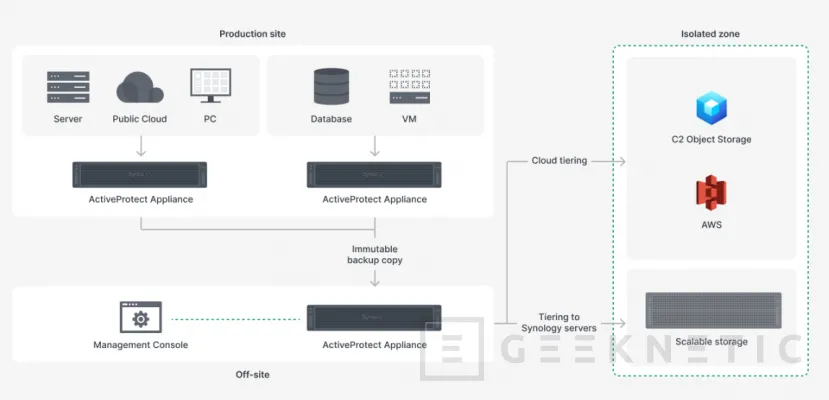
Synology claims to offer up to 7x backup performance with 2:1 deduplication factor. This means that, if we have to copy 2TB of data, the compressed information will be only 1TB, reducing the space consumed and the transit of information on the network.

Copies can be completely isolated from the internet (air-gapped), or the rest of the systems, protecting them from very common attacks such as Ransomware with configurable modes and periods. It also allows field testing, such as information recovery, in a completely isolated “sandbox” environment and on the copy machine itself, without the need for additional resources.
The hardware available
This entire product range is based on already existing units, The change that Synology is really looking for is not in the hardware but in the software, another clear proof that this brand has long been a company that sells and markets Software and not hardware. Also doing it brilliantly, with excellent support and a deep understanding of the needs of its clients and users.
By this I mean that we will not see major hardware advances or the introduction of more powerful processors and it is precisely that we are looking for a completely optimized and protected ecosystem, only designed for backups.
We know that Synology will put several DP units on the market, at least for now in Rack format, but at the moment only one model has been announced, the Synology DP7400 in 2U Rack format. It will soon be accompanied by smaller DP3400 units intended for delegations, departments, etc.
| Form factor | 19″ 2U Rack | |
| Usable Storage | 140TB | |
| Copy capacity | Data by origin | 83.5TB |
| Source devices | 350 | |
| SaaS accounts | 3300 | |
| Processor | EPYC 7272 | |
| RAM (GB) | 64GB | |
| Management port | 1 x 1GbE | |
| Network interfaces | 2 x 10GbE | |
| Storage | ||
| HDD | 10 x 20TB | |
| RAID Type | RAID 6 + 1 hot spare | |
| SSD | 2 x 3840GB (RAID 1) | |
The Synology DP7400 has hardware already known in other models of the brand. An EPYC 7272 processor based on “Zen 2” architecture with 12 cores and 24 process threads. It has 64MB of third-level cache, support for up to 4TB of DDR4 memory in eight channels, although in this unit we will have 64GB installed as standard.
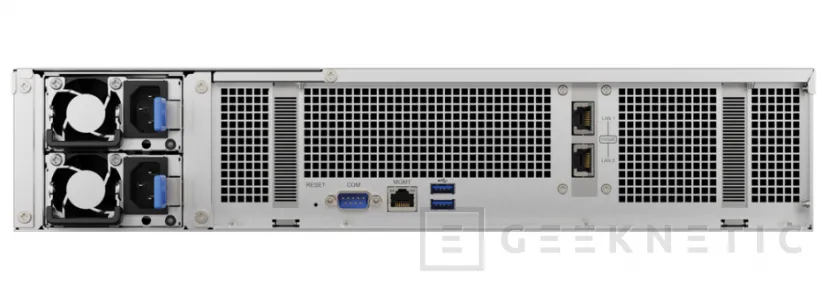
Synology leaves room for 10 quick-release drives in 3.5” SATA format with capacity for 20TB per drive in RAID 6 + 1, a drive waiting as a Hot-Spare. This gives us a maximum of 140TB of storage on this unit with all drives installed.
Synology will market the unit with two SATA SSD storage units of 4TB each that will work in cache mode for main storage. Network connectivity is normal, so to speak, with 1 Gigabit interface for management and two 10GbE interfaces that can operate in aggregate or fault-tolerant modes.
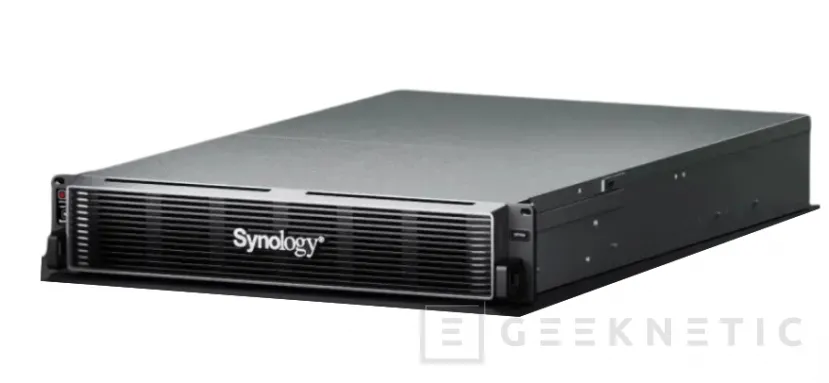
Among other interesting technical data, we have a limit of 83.5TB per copy, a maximum of 350 manageable copy sources and a maximum of connections to 3,300 SaaS services (cloud services such as Google Workspace or Microsoft 365). If you are wondering if you can convert any of the currently existing DSM-based NAS and install ActiveProtect, the answer is directly no; It is not in Synology’s plans to mix both environments in any way.
Conclusion
At the beginning of this article I reflected on how much we have been wrong regarding Synology as a hardware manufacturer. Perhaps it was like this at some moments in its beginnings, but once the foundations of what the brand has needed at the hardware level, such as designs, drive formats, disk bays, network interfaces,… everything has been developed after software.
Now the brand takes a step forward to achieve a copy ecosystem completely oriented towards that, making backup copies. With incredible power to connect with all types of sources, to control all these environments centrally, to achieve adequate scalability for the client, protect copies from new threats, improve management so that making backup is not a problem but an operational advantage and also so that disaster recovery times are minimized.
It seems as if this unit reduces its potential, without offering all that customization potential of DSM operating system functions, but the truth is that a simplified and completely specialized copy solution is surely what many business and government environments are desperately looking for now that It seems no one is immune from a potential security disaster. ActiveProtect seems to have the answer for these environments, perhaps not to avoid risk, that is not what this operating system is for, but so that when the time comes the recovery is agile and reaches all the sensitive elements of the organization.
End of Article. Tell us something in our Forum!






![[Img #74676]](https://thelatestnews.world/wp-content/uploads/2024/12/Laser-artificial-neuron-150x150.jpg)





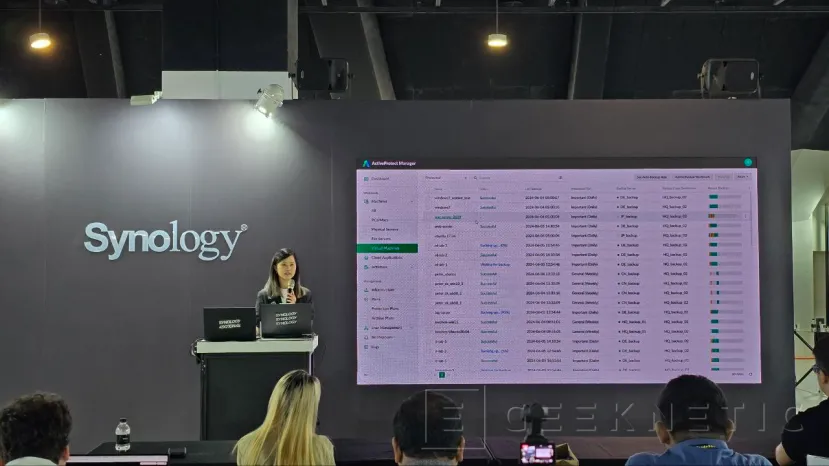

Add Comment